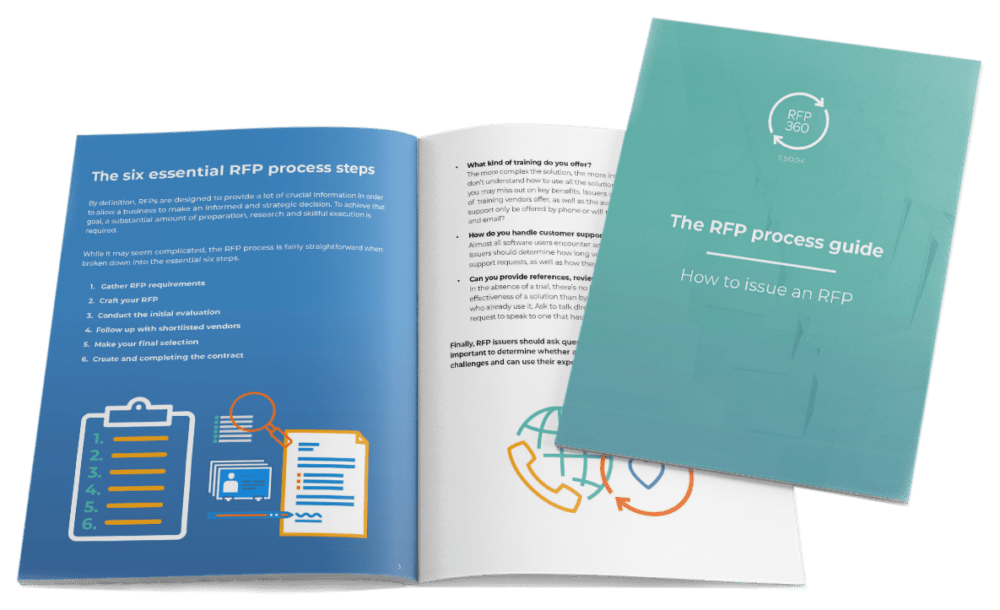Clear, concise RFP requirements are a crucial element of any successful RFP project. As one of the first steps of the request for proposal (RFP) process, building thoughtful requirements gets you and your stakeholders on the same page. In addition, once defined, RFP requirements serve as a guide when writing RFP questions as well as evaluating vendor proposals.
However, far too often, this valuable step of the RFP process is rushed or skipped altogether. Unfortunately, without clear requirements, you may find yourself stuck with the wrong vendor and unhappy stakeholders.
In this post, I’ll define what RFP requirements are, why they are so important and how to write them. In addition, you’ll learn about different types of requirements common in RFPs as well as tips for creating exceptional RFP requirements.
- What are RFP requirements?
- Types of RFP requirements
- The importance of establishing RFP requirements
- How to gather and write requirements
- Quick tips for using RFP requirements
What are RFP requirements?
RFP requirements definition
RFP requirements are statements that express the needs and considerations for a procurement project. Buyers use these requirements to write RFPs and evaluate subsequent vendor proposals. Typically, each set of requirements is specific to a single procurement project and gathered from various internal stakeholders impacted by the project.
Types of RFP requirements
As you work with RFPs, you’ll encounter several kinds of requirements. Some RFP requirements are categorized by their importance, while others are grouped by topic. To avoid confusion, it’s important to understand the differences between them.
Minimum requirements or critical requirements
In RFPs, minimum requirements, also called critical requirements, are essential to the project’s success. Indeed, these elements are what you consider the project’s deal breakers. Typically these requirements are expressed using statements that begin with, “The vendor must…”
Generally, if a potential vendor cannot meet each of your minimum requirements, they should not submit a proposal. If they do, you must decide if you will choose to include the unqualified proposal in your RFP evaluation process.
Functional requirements
When undertaking a technical project, functional requirements state what tools your users will leverage to achieve their objectives. For example, a functional requirement for RFP software might state, “The solution must support multi-user collaborative RFP requirements writing and real-time change tracking.”
Technical requirements
Similar to functional requirements, technical requirements are common in IT and software RFPs. However, technical requirements detail how the proposed solution will work as well as how it will integrate with your existing technology and network.
Contractual requirements
An RFP may include contractual requirements that detail terms and conditions necessary to formalize a partnership between you and a vendor. These requirements are not essential to the RFP, but may speed the negotiation and contracting process once you select a vendor.
Management requirements
Management requirements document your expectations for the project with your chosen vendor. For instance, these requirements may include guidelines for solution implementation, training, customer support and so on.
Submission requirements
RFP submission requirements detail how vendors should submit their proposals to you. For instance, you can specify the maximum number of pages, document format and delivery method. Take advantage of submission requirements to make RFP evaluation easier for you and your team.
Business requirements
Business requirements are the goals your organization plans to achieve by partnering with a specific vendor. Generally used after the RFP process, once a vendor is selected, a business requirements document (BRD) provides more detail about the organization’s needs in a single reference guide.
Download the business requirements document template here.
The importance of establishing RFP requirements
As the foundation of your RFP process, well-written RFP requirements deliver benefits from start to finish.
More engaged stakeholders
Engaging stakeholders from various departments at the beginning of the RFP process sets expectations for everyone involved. As you learn more about the project’s challenges and goals, stakeholders will likewise develop a deeper appreciation for the procurement process. In addition to creating comprehensive RFP requirements, together you can set realistic internal expectations for the RFP timeline.
Fewer unqualified vendors
Creating RFP responses is an investment for vendors. Similarly, evaluating proposals is time consuming for you as the RFP issuer. Naturally, both parties want to spend their time wisely.
While you don’t want to discourage creative solutions, there are some factors that just can’t be compromised. So, by including minimum requirements in your RFP, you enable unqualified vendors to gracefully decline opportunities that aren’t a good fit — saving you both time and money.
Better RFP responses
Researching and writing thorough RFP requirements saves time when writing the RFP. Not only that, but referencing the agreed upon requirements while writing the RFP enables clearer, more focused RFP questions and eliminates potential blind spots and gaps. The result? Fewer follow-up questions from vendors and higher-quality, more complete responses.
Clear vendor evaluation
After receiving the vendor proposals, pre-established RFP requirements guide the RFP process once again by helping to prioritize requirements. Then, applying weighted scoring to the responses makes identifying a clear winner fast and easy.
How to write gather and write requirements
For many procurement managers, the RFP requirements process is manual. It begins when informal, unorganized wish lists created by multiple stakeholders, begin arriving in your inbox. Understandably, it can be easy to get overwhelmed by the stack of requests.
You can use the steps below to bring order and efficiency to your manual process or use RFP software to centralize and automate your requirements gathering.
1. Identify project stakeholders
Creating RFP requirements is a collaborative process. So, you have to decide who the procurement project should involve. While you don’t need feedback from everyone, it’s important to get perspectives from at least one person in each role and step of the current process.

RFP project stakeholder roles
Individual contributors
The department that identified the need or is sponsoring the project is a good place to start. Here you’ll find individual contributors directly impacted by the problem who are eager to help find a solution. Indeed, this boots-on-the-ground perspective is a wealth of information about needs and general requirements.
Subject matter experts
Next, find out if there is a subject matter expert (SME) closely aligned with the type of procurement project you’re undertaking. Some SMEs may not be in the department where the request originated. For instance, if you are considering RFP management software for procurement, it may be helpful to discuss the project with a proposal coordinator who is an expert at responding to RFPs. They’ve likely worked with various platforms and tools and can offer new considerations.
Executive approvers
After discussing the problem and potential solutions with individual contributors and SMEs, it’s time to engage with the project approver(s). While they also want to solve the problem at hand, they bring a big-picture perspective to the discussion. Accordingly, they may have additional considerations or parameters to add to your critical requirements.
IT
Early input from the IT department is particularly important for software or technology procurement projects. Explore technical and functional requirements like solution compatibility, integration and data security.
Finance
Budget and pricing is always part of the RFP process. Engage the finance department to discover their needs and include them in your contractual requirements.
Legal
Similar to finance, the legal team should be involved in creating your contractual requirements. Work with them to provide any non-disclosure requirements or other required legal documentation.
2. Gather internal requirements
After you’ve identified the stakeholders involved in your project, it’s time to ask questions. It’s best to approach stakeholders in the order outlined above. Work with individual contributors and SMEs to develop an understanding of the current process and problem. Then, refine your definition of the challenge and gather additional requirements by moving up and out on the organizational chart.
Begin discussions with those most closely impacted by the problem. To best understand the problem, Project Management Institute recommends mapping the current process.
“Start by writing down each step. Visit the people that perform each step and ask them what they do, in what order and why. Be prepared for some surprises. There will be steps you did not know about and people taking shortcuts you never imagined.”
After mapping the process, rather than simply asking stakeholders what they want, guide feedback by asking the roles involved specific prompting questions.
- How is your work in the process completed now?
- What steps in the current process are ineffective or inefficient?
- Are there parts of the process that work well and should stay the same?
- What are your goals for this project?
- How would specific new functionality help you achieve these outcomes?
- Which goals are the highest priority?
- What other considerations should be taken into account?
3. Collate, organize and prioritize requirements
Now, you’ve talked to everyone involved, understand the problem and have a long list of requests and requirements. At this point, the information you’ve gathered probably looks like the result of a frantic group brainstorming session. You have collected ideas about all aspects of the project written by a dozen different people with competing interests. And, you are responsible for bringing it all together.
Begin by organizing the feedback. Categorize the information by theme — general, functional, technical, management or contractual requirements. Once your lists are consolidated and grouped, look for requirements that appear more than once. Combine these items into a single requirement, but be sure to keep track of which stakeholders provided the information.
Write your RFP requirements as statements. Start each statement with phrases like:
- The vendor must …
- There must be …
- The solution should …
Finally, reorder the requirement statements based on their importance to the project. Elements that were mentioned by more than one stakeholder should be high on your list of priorities.
Quick tips for using RFP requirements
Building RFP requirements takes time and effort, so it is important to make sure you make the most of them. Here are some final quick tips to help.
- If possible, limit the number of minimum or critical requirements to less than six. Designating too many factors as essential will discourage vendors from providing creative solutions that may be the perfect fit for your project.
- Avoid creating compound requirements. Focus on one element, function or goal per statement. Furthermore, think of the requirements as a checklist for vendors. Indeed, simple requirements allow them to quickly indicate which needs they satisfy fully, which they partially meet and which they cannot accommodate.
- Formalize and share your RFP requirements with the stakeholders who helped shape them. This will close the loop and encourage participation in the future. In addition, include the document in your RFP kickoff meeting so everyone involved is on the same page.
- Use the requirements document as an outline for building your RFP. Form each requirement type into a section and each individual requirement in to one or more questions. Then, use the requirements to create high-level RFP evaluation criteria that help vendors know what elements matter most to your organization.
Creating comprehensive RFP requirements helps you, your stakeholders and potential vendors understand your challenges, needs and vision. The result? Confident vendor selection, happy stakeholders and more successful outcomes.
Need more information? Learn more about how to find the right vendor using the RFP process in this RFP process guide ebook.




